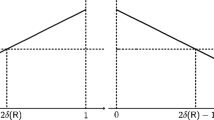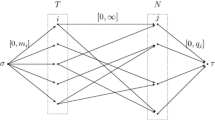Abstract
We consider a problem of allocating infinitely divisible commodities among a group of agents. More specifically, there are several commodities to be allocated and agents have continuous, strictly convex, and separable preferences. We establish that a rule satisfies strategy-proofness, unanimity, weak symmetry, and nonbossiness if and only if it is the uniform rule. This result extends to the class of continuous, strictly convex, and multidimensional single-peaked preferences.
Similar content being viewed by others
References
Adachi T (2010) The uniform rule with several commodities: a generalization of Sprumont’s characterization. J Math Econ 46: 952–964
Amorós P (2002) Single-peaked preferences with several commodities. Soc Choice Welf 19: 57–67
Anno H, Sasaki H (2009) Second-best efficiency of allocation rules: strategy-proofness and single-peaked preferences with multiple commodities. Working Paper, Waseda University
Barberà S, Jackson MO (1995) Strategy-proof exchange. Econometrica 51: 51–87
Barberà S, Gul F, Stacchetti E (1993) Generalized median voter schemes and committees. J Econ Theory 61: 262–289
Barberà S, Jackson MO, Neme A (1997) Strategy-proof allotment rules. Games Econ Behav 18: 1–21
Barberà S, Massó J, Serizawa S (1998) Strategy-proof voting on compact ranges. Games Econ Behav 25: 272–291
Barberà S, Berga D, Moreno B (2010) Individual versus group strategy-proofness: when do they coincide?. J Econ Theory 145: 1648–1674
Bénassy JP (1982) The economics of market disequilibrium. Academic Press, New York
Bogomolnaia A, Deb R, Ehlers L (2005) Strategy-proof assignment on the full preference domain. J Econ Theory 123: 161–186
Border KC, Jordan JS (1983) Straightforward elections, unanimity and phantom voters. Rev Econ Stud 50: 153–170
Ching S (1994) An alternative characterization of the uniform rule. Soc Choice Welf 11: 131–136
Ching S, Serizawa S (1998) A maximal domain for the existence of strategy-proof rules. J Econ Theory 78: 157–166
Ehlers L, Klaus B (2003) Coalitional strategy-proof and resource-monotonic solutions for multiple assignment problems. Soc Choice Welf 21: 265–280
Fleurbaey M, Maniquet F (1997) Implementability and horizontal equity imply no-envy. Econometrica 65: 1215–1219
Foley D (1967) Resource allocation and the public sector. Yale Econ Essays 7: 45–98
Hatfield JW (2009) Strategy-proof, efficient, and nonbossy quota allocations. Soc Choice Welf 33: 505–515
Le Breton M, Sen A (1999) Separable preferences, strategyproofness, and decomposability. Econometrica 67: 605–628
Le Breton M, Zaporozhets V (2009) On the equivalence of coalitional and individual strategy-proofness properties. Soc Choice Welf 33: 287–309
Maskin E (1999) Nash equilibrium and welfare optimality. Rev Econ Stud 66: 23–38
Massó J, Neme A (2001) Maximal domain of preferences in the division problem. Games Econ Behav 37: 367–387
Massó J, Neme A (2007) Bribe-proof rules in the division problem. Games Econ Behav 61: 331–343
Miyagawa E (2001) House allocation with transfers. J Econ Theory 100: 329–355
Mizobuchi H, Serizawa S (2006) Maximal domain for strategy-proof rules in allotment economies. Soc Choice Welf 27: 195–210
Morimoto S, Serizawa S, Ching S (2010) A characterization of the uniform rule with several commodities and agents. Osaka University, ISER discussion paper no. 769
Moulin H (1980) On strategy-proofness and single-peakedness. Public Choice 35: 437–456
Otten G, Peters H, Volij O (1996) Two characterizations of the uniform rule for division problems with single-peaked preferences. Econ Theory 7: 291–306
Pápai S (2000) Strategyproof assignment by hierarchical exchange. Econometrica 68: 1403–1433
Sasaki H (2003) Limitation of efficiency: strategy-proofness and single-peaked preferences with many commodities. Working paper, Rice University
Satterthwaite MA, Sonnenschein H (1981) Strategy-proof allocation mechanisms at differentiable points. Rev of Econ Stud 48: 587–597
Schummer J (2000) Eliciting preferences to assign positions and compensation. Games Econ Behav 30: 293–318
Serizawa S (1996) Strategy-proof and individually rational social choice functions for public good economies. Econ Theory 7: 501–512
Serizawa S (2002) Inefficiency of strategy-proof rules for pure exchange economies. J Econ Theory 106: 219–241
Serizawa S (2006) Pairwise strategy-proofness and self-enforcing manipulation. Soc Choice Welf 26: 305–331
Sprumont Y (1991) The division problem with single-peaked preferences: a characterization of the uniform allocation rule. Econometrica 59: 509–519
Svensson L-G, Larsson B (2002) Strategy-proof and nonbossy allocation of indivisible goods and money. Econ Theory 20: 483–502
Thomson W (1990) The consistency principle. In: Ichiishi T, Neyman A, Tauman Y (eds) Game theory and applications, proceedings of the 1987 international conference, Ohio State University, Columbus, Ohio. Academic Press, pp 187–215
Thomson W (1994a) Consistent solutions to the problem of fair division when preferences are single-peaked. J Econ Theory 63: 219–245
Thomson W (1994b) Resource-monotonic solutions to the problem of fair division when preferences are single-peaked. Soc Choice Welf 11: 205–223
Thomson W (1995) Population-monotonic solutions to the problem of fair division when preferences are single-peaked. Econ Theory 5: 229–246
Thomson W (1997) The replacement principle in economies with single-peaked preferences. J Econ Theory 76: 145–168
Thomson W (2004) Consistency and its converse: an elementary introduction. University of Rochester, Mimeo
Thomson W (2010) Implementation of solutions to the problem of fair division when preferences are single-peaked. Rev Econ Des 14: 1–15
Author information
Authors and Affiliations
Corresponding author
Rights and permissions
About this article
Cite this article
Morimoto, S., Serizawa, S. & Ching, S. A characterization of the uniform rule with several commodities and agents. Soc Choice Welf 40, 871–911 (2013). https://doi.org/10.1007/s00355-011-0648-9
Received:
Accepted:
Published:
Issue Date:
DOI: https://doi.org/10.1007/s00355-011-0648-9




